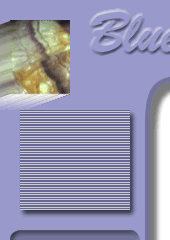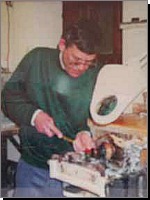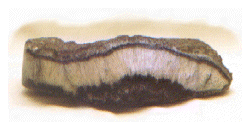 |
||
|
NEW:
Restoring a
Blue John Urn
Edward Fisher's
Masterpiece
Last Updated : Sat, 28-Jul-2007 © copyright 2001, 2007 HCI Data Ltd. |
||
 |
Blue John Stone
Blue John
Stone is a rare, semiprecious mineral found at only one location in the world - a hillside near Mam Tor, just outside
Castleton,
in the Derbyshire Peak District National Park, England. The name Blue John derives from the French Bleu
Jaune meaning Blue Yellow.
 It is a form of
fluorite and was discovered as miners were exploring the cave systems of Castleton
for lead.
It is a form of
fluorite and was discovered as miners were exploring the cave systems of Castleton
for lead.
Nowadays, the caves of Castleton are magnificent show caves and are some of the most popular tourist attractions in Derbyshire. Of the four show caves only Treak Cliff and, to a lesser extent, Blue John have veins of Blue John Stone. Treak Cliff Cavern still mines about 500 kilograms of Blue John Stone each year. The veins of Blue John Stone are easy to see and many of the formations are well lit. Blue John Stone is a semiprecious stone and gives Castleton its nickname of 'Gem of the Peaks'.
Chemically, Blue John is calcium fluoride (CaF2) which has been coloured by films of
oil deposited on the crystals millions of years ago.
Although it is known as fluorite the old miners, referred to it as fluor spar (sometimes spelt fluorspar). Fluorite often forms in cubic and octahedral
crystals and is usually grey, yellow or purple in colour. Fluorite used to be mined
mainly for iron smelting but now has many other uses including toothpaste. The form of fluorite unique to Castleton is banded purple and
yellow or grey and is known as Blue John.
The form of fluorite unique to Castleton is banded purple and
yellow or grey and is known as Blue John.
Banded Blue John fluorite has been worked into ornaments since 1750 and there are about 14 categories of banding patterns.
Blue John has been prized for ornaments and jewellery and it can be found in many great collections housed in places such as Windsor Castle, the White House and the Vatican.
Old craftsman dried the Blue John stone and noticed that it changed colour to pink and red. It is not clear if this was discovered by accident as a result of a mistake in drying the stone. At 230°C (450°F) the Blue John stone changes colour but at these temperatures, gases are produced. These gases could at explode and destroy the piece.
Some items in this website use a mineral called Derbyshire Tiger Stone. This comes from the rear of the quarry behind the cement work at Hope, near Castleton.
Watch Edward Fisher talking about Blue John Stone Objects.
Edward Fisher demonstrating how blue john stone is transformed into buetiful objects.
Use the buttons on the left to view artefacts skilfully created from Blue John Stone.
All are handmade by Edward Leonard Fisher.
